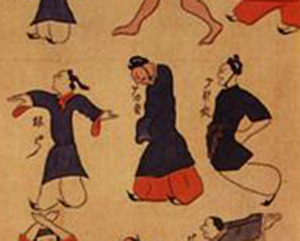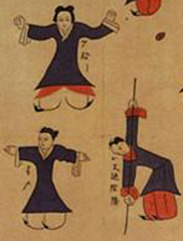The Guiding and Pulling Chart, Changsha Kingdom, ca. 160 BCEThe chart is painted on wilk and was exc
The Guiding and Pulling Chart, Changsha Kingdom, ca. 160 BCEThe chart is painted on wilk and was excavated from the Western Han Mawangdui (馬王堆) archeological site in Hunan province in 1973. It shows forty-four people - men and women, young and old - engaged in a kind of gymnastics believed to heal some diseases and extend life. These gymnastics are considered to be the ancestor of the exercises called qigong (气功) practiced today in China and all over the world.“Guiding and pulling” (Daoyin 導引) refers to the different postures involved in these exercises. The physical basis for daoyin is qí (气). In the last centuries before the beginning of the Common Era, the Chinese came to believe that the whole world and everything in it was made of qí. Qí was the basis of Chinese medicine and wellness the result of qí circulating freely throughout the body. Exercises could help qí circulate properly.More here and here -- source link
#daoyin#導引#qígong#气功#chinese medicine#chinese wellness#mawangdui#馬王堆#changsha#gymnastics#health#exercise


